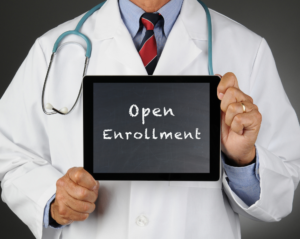
by admin | Sep 4, 2024 | Employee Benefits, Hot Topics, Open Enrollment
 Navigating health insurance can feel like planning a vacation. You wouldn’t pack for a beach trip if you’re headed to the mountains, right? Similarly, choosing a health plan requires careful consideration.
Navigating health insurance can feel like planning a vacation. You wouldn’t pack for a beach trip if you’re headed to the mountains, right? Similarly, choosing a health plan requires careful consideration.
Open enrollment is your chance to design a plan tailored to you; it is your yearly opportunity to review and adjust your employee benefits package.
What is Open Enrollment?
Open enrollment is a specific window of time, typically every autumn, when employees can enroll in, change, or drop benefits offered by their employer. These benefits typically include health insurance, dental, vision, life insurance, and medical spending accounts. Outside of this period, changes are usually only allowed under special circumstances. Open enrollment is like a health checkup for your financial well-being, ensuring you have the right coverage to protect yourself and your family.
Why is Open Enrollment Important?
- Life Changes: Major life events like marriage, birth, or adoption can significantly impact your benefit needs.
- Plan Changes: Insurance providers often adjust their plans and rates annually.
- Cost Control: Reviewing your options can help you find ways to save money on premiums and out-of-pocket costs.
- Maximizing Benefits: Ensure you’re taking full advantage of the benefits offered by your employer. You may even discover hidden gems in your plan like discounts or a wellness program within your current plan.
Tips for Open Enrollment Success:
- Understand Open Enrollment Terms
- Review Your Current Coverage: Understand your existing benefits and how you’ve used them throughout the year.
- Estimate Healthcare Costs: Consider factors like doctor visits, prescriptions, and potential major medical expenses.
- Compare Plan Options: Evaluate different plans based on premiums, deductibles, copays, and network size.
- Involve Your Family: Discuss your options with your family to ensure everyone’s needs are met.
- Ask Questions: If you have questions, don’t hesitate to contact your HR department or benefits provider.
- Remember the 4 D’s When Choosing a Plan: Take into account doctors, drugs, diagnostics and deductibles. Be sure your doctors are in-network, your drugs are covered, and key diagnostic tests like blood tests and imaging are accessible and your deductible meets your financial needs.
Open enrollment season is right around the corner! Take the time to prepare now; remember, the decisions you make during open enrollment can have a significant financial impact on you for the following year. So, be sure to read up, think of your options, and select carefully!

by admin | Sep 27, 2023 | Employee Benefits
 For millions of Americans, the end of the year is open enrollment season – a yearly opportunity to take stock of your health care needs and select the health insurance plan that works best for you. It is a window of time – typically in the fall – when you can sign up for health insurance, review, assess, and modify your existing benefits.
For millions of Americans, the end of the year is open enrollment season – a yearly opportunity to take stock of your health care needs and select the health insurance plan that works best for you. It is a window of time – typically in the fall – when you can sign up for health insurance, review, assess, and modify your existing benefits.
There are more choices than ever to help you find a plan that will best suit your health needs. Think of it like planning a trip: you don’t pack a surfboard if you are planning to hike in the mountains. Likewise, there is a lot to think about when selecting a health plan for the next year. What does it cost? Does it include your prescription or preferred doctors? Understanding health insurance basics and how open enrollment works is essential for making informed choices about your benefits and insurance coverage.
Here’s How Open Enrollment Typically Works:
- Eligibility: Anyone eligible for health insurance can participate in Open Enrollment. This includes you, your dependents, and individuals looking to buy insurance through the individual marketplace (e.g., through the ACA exchanges)
- Review Options: During the Open Enrollment period, you have the opportunity to review your current insurance coverage and assess their healthcare needs for the upcoming year. You should consider factors like changes in your health, anticipated medical expenses, and any new coverage options that might be available.
- Enrollment or Changes: You can use the Open Enrollment period to either enroll in a new insurance plan, make changes to your existing plan, or renew your current coverage. This might involve switching plans, adding or removing dependents, changing coverage levels, or adjusting other plan details.
- Deadline: Open Enrollment is time sensitive. Once the designated period ends, you generally cannot make changes to your insurance coverage until the next Open Enrollment period unless you experience a qualifying life event (such as marriage, birth of a child, job loss, or relocation), which triggers a Special Enrollment Period.
- Coverage Start: The new coverage usually begins at the start of the upcoming calendar year, though this can vary depending on the specific insurance plan and enrollment date.
Which Plans Don’t Use Open Enrollment?
- CHIP (Children’s Health Insurance Program) – CHIP offers low-cost health coverage for children from birth through age 18. CHIP permits enrollment at any time so you can ensure your children have coverage year-round.
- Medicaid – Medicaid is a joint federal and state program that helps cover medical costs for some people with limited income and resources. Medicaid allows enrollment in health insurance during any time of year, provided you qualify.
- Short-Term Health Insurance – health insurance plan with a limited duration, typically several months to a year. These plans are geared toward people who need temporary medical insurance to bridge the gap between longer-term plans. These plans don’t have enrollment periods because the need for this type of insurance is difficult to predict.
It’s important to note that missing the Open Enrollment period without a qualifying life event can result in being without health insurance coverage until the next Open Enrollment period. To ensure you have the coverage you need, carefully review your options and make any necessary changes during the designated Open Enrollment timeframe.
Health insurance providers are committed to helping all Americans make informed health coverage choices for themselves and their families. Open Enrollment is a great time to explore the benefits already available to you in your current plan, including discounts and wellness opportunities that can save you money and keep you healthy.

by admin | Oct 11, 2022 | Employee Benefits, Open Enrollment
 Choosing the right benefits during open-enrollment season is so important and can help save money. It can also give individuals and families broader support with their health. Benefits like medical coverage are particularly important with high inflation having such a big impact on people’s budgets.
Choosing the right benefits during open-enrollment season is so important and can help save money. It can also give individuals and families broader support with their health. Benefits like medical coverage are particularly important with high inflation having such a big impact on people’s budgets.
A survey by UnitedHealthcare found that nearly 40% of employees devote less than one hour to the open enrollment process. It is crucial to carefully analyze your benefits during open enrollment as any decisions you make will likely be locked for the year until the next open enrollment period. Don’t rush into open enrollment without carefully considering your options!
Here are some tips to ensure you make the most of your open enrollment:
Be Prepared
Open enrollment typically lasts for a short period (2-4 weeks) so knowing what you need to do ahead of time can be a big stress reliever. A good starting point is to consider how your needs have changed since last year. For example, maybe you got married or received a raise. These changes may require a change in coverage, whether it be for life, health or disability insurance, and it is important to consider how these or any other expected life changes will impact your insurance needs.
Review Any Changes Made by Your Employer
It is common for employers make changes to plans and premiums to keep up with the times. When you receive your open enrollment packet to review plan options, it is important to consider all aspects of coverage and the total cost of coverage. The total cost is impacted by the deductibles, premiums, co-insurance and maximum out-of-pocket expenses.
Take note of whether your employer made any changes in providers. If this happens, your current physician or dentist may be out-of-network which will result in out-of-network costs or denied claims.
Review Your Insurance Options
The largest portion of employer benefits is health insurance so it is important to choose the plan that is best for you and your family. Important questions to ask are: how often do you have medical expenses? Are lower premiums or lower out-of-pocket costs more important to you? Do you take expensive prescription drugs? Can you afford hefty out-of-pocket costs if there is an emergency?
There are 3 main plan types:
- Preferred Provider Organization (PPO)
PPO’s are a popular choice since they allow you to see any doctor or specialist and don’t require a referral from your primary care physician (PCP) to see a specialist. However, PPO premiums are usually much more than other plans. To help reduce costs, remember that using in-network providers and specialists who are part of your PPO network will save you money.
- Health Maintenance Organization (HMO)
HMOs have lower premiums than PPOs but they require you to stay in-network. You will also need a referral from your PCP to see a specialist. The idea is that the PCP coordinates your care.
- High Deductible Health Plan (HDHP)
Another low-cost option is a high-deductible health plan. What sets HDHPs apart from other plans is their low premiums and high deductibles. That means you won’t have to pay as much each month for premiums but you will need to pay more of the healthcare costs when you need services. To help you pay for the bigger deductible, employers usually pair an HDHP with a health savings account (HSA), which allows you to save for medical expenses, including deductibles and copays.
Learn How FSAs, HRAs, and HSAs Differ
Many employers offer accounts that help you save for medical expenses:
- Flexible Spending Account (FSA)
You decide how much pre-tax money to put into the employer owned account through payroll deductions and then you can use that money to pay for out-of-pocket medical expenses. You lose that money if you change jobs or don’t use it by the end of the year.
- Health Savings Account (HSA)
Connected to a HDHP, an HSA lets you set aside money on a pre-tax basis to pay for qualified medical expenses. The account is yours, so you keep it if you change jobs. The money rolls over each year so you don’t have to worry about “using it or losing it.”
- Health Reimbursement Arrangement (HRA)
An HRA is similar to an HSA except that the employer owns the account so you can’t take it with you when you change jobs. You’re able to contribute money for medical expenses just like an HSA or FSA. Money can also be carried over to the next year like an HSA.
Open enrollment is an important time of year and is worth investing some time and energy to decide what is best for you and your family. Health insurance is one of the most important purchases you make. By doing your homework and taking the time to carefully consider your options, you’ll find the plan that is right for you!

by admin | Oct 5, 2022 | Health Insurance, Open Enrollment
 For most employers, employee benefits represent a significant portion of their overall budget and a critical part of their employee recruitment and retention strategy. Benefits vary from employer to employer but can range from medical or dental insurance to flexible spending accounts, life and disability insurance, and more. The annual process of renewing those benefits involves a great deal of work, most of which is unseen by employees.
For most employers, employee benefits represent a significant portion of their overall budget and a critical part of their employee recruitment and retention strategy. Benefits vary from employer to employer but can range from medical or dental insurance to flexible spending accounts, life and disability insurance, and more. The annual process of renewing those benefits involves a great deal of work, most of which is unseen by employees.
As you finalize your benefits lineup for the next year and hold your first open enrollment meeting, we’re sharing five tips related to common issues we hear from Mineral customers each year.
There are different ways to handle benefit elections. They range from affirmative or “active” elections that require everyone to select options, to evergreen “rolling” elections that only require employees to take action if they want to make changes. There are also many other options in between. Which option an employer chooses depends on their strategy for participation, the types of benefits they offer, state wage deduction rules, and other factors. Before you get started with benefits elections:
- Double check to confirm that any election rules you are using during open enrollment match what was discussed with your insurance carrier or third-party administrator (TPA), as well as matching what you say to employees in plan materials and open enrollment communications.
- Decide what happens if an employee who is enrolled in coverage takes no action during open enrollment. Will their coverage be dropped? Will some or all of their elections carry over to the next plan year? Clearly communicate the consequences of inaction, if any.
Don’t Forget About COBRA!
Federal COBRA applies to most employers that offer group health coverage and that have 20 or more employees. COBRA allows employees (and certain dependents) who experience qualifying events during the plan year to continue coverage for a period of time, at their own cost. Many states have similar laws for employers with fewer than 20 employees, often called “mini-COBRA” laws. Individuals who have elected federal COBRA have many of the same rights as active participants and must be provided the option to waive or elect coverage or add or remove dependents as well. To notify employees of their COBRA rights:
- Clarify who is responsible for sending open enrollment information to COBRA qualified beneficiaries. If you administer COBRA in-house, ensure the person responsible knows open enrollment communications should include COBRA qualified beneficiaries.
- If you are using a third-party vendor for COBRA administration, make sure they send any required communications or paperwork to eligible employees. If the vendor doesn’t do this, the responsibility generally falls on the plan sponsor (the employer).
Leverage Attention
The open enrollment period happens when employees are paying closer attention to benefit-related topics. Open enrollment meetings and communications can present additional opportunities to gather data and insight into the needs and experiences of participants in your benefit programs. Use this time to:
- Consider including an employee survey or otherwise collecting feedback, even anecdotally, on areas of interest or concern. This might include asking for feedback on the open enrollment process and communications. If you hear grumbling about a specific process or hear people express confusion about a particular option, that can be a great way to identify opportunities for education or change. For example, if several people mention in an open enrollment meeting that drug prices are too high, you might decide to send a follow-up communication to remind employees about bulk mail order prescriptions and the additional value that can provide.
- Consider a dependent audit. Dependent audits ensure only eligible individuals are on the plan, which keeps employers in compliance with their plans as written and reduces any unnecessary costs for ineligible dependents. Timing an audit to occur just before or during open enrollment can reduce compliance complications if a dependent is deemed ineligible.
Carefully Review Salary Deduction Agreements
Benefit costs typically change from year to year and most state wage and hour laws require employees to authorize payroll deductions for benefit contributions. Use this time to review your existing deduction agreements and ensure they cover the most current options. Then gather updated deduction agreements from employees. As you review these agreements, consider the following questions:
- Do they clearly indicate the approved amounts to be deducted from pay and the frequency?
- What rights do employees have to choose whether or not their cost share is taken pre-tax or after-tax? If you have a § 125 cafeteria plan in place, confirm the options available so your deduction agreements accurately reflect the choices available to employees.
- Do they address deductions from final pay (e.g., double deductions)? Caution: Cafeteria plan rules do not allow for double deductions from final pay in most cases, and state wage and hour laws can heavily restrict this as well.
Align Processes
Carefully review your electronic or online benefits enrollment systems to confirm the options and language align with the plan rules, and consider the following:
- If you use a universal enrollment form or electronic system, confirm they contain any insurance carrier or TPA required arbitration or enrollment language, so the election is considered valid.
- Put an audit process in place so that, after open enrollment, you can confirm the elections made by employees are transmitted to the carrier/TPA accurately and payroll entries are aligned.
- Provide employees with a confirmation statement that outlines their final election choices and deduction agreements. Also, consider reminding employees to confirm this statement against their first payroll of the new plan year to make sure it reflects their choices. Both steps can go a long way to catching mistakes early, when they are easiest to compliantly correct.
Planning ahead can result in a more effective, streamlined process for the employer and clarity for employees.
By Eeloria Brown
Originally posted on Mineral

by admin | Sep 21, 2021 | Employee Benefits, Open Enrollment
 When the autumn leaves fall and the weather turns cooler, we know it’s time to start thinking of open enrollment. Open enrollment season can be a confusing time. As you begin your research into which plan to choose or even how much to contribute to your Health Savings Account (HSA), consider evaluating how you used your health plan last year. Looking backward can help you plan forward to make the most of your health care dollars for the coming year. Here’s what you need to know about your workplace benefits to maximize them:
When the autumn leaves fall and the weather turns cooler, we know it’s time to start thinking of open enrollment. Open enrollment season can be a confusing time. As you begin your research into which plan to choose or even how much to contribute to your Health Savings Account (HSA), consider evaluating how you used your health plan last year. Looking backward can help you plan forward to make the most of your health care dollars for the coming year. Here’s what you need to know about your workplace benefits to maximize them:
1). Know the Open Enrollment Dates
It is up to you to make sure you take advantage of the open enrollment period. Be sure you know when your company has open enrollment because it can be your only time to adjust benefits for the coming year.
2). Evaluate Your Current Benefits
Before open enrollment starts, review the benefits you currently are receiving. Your pay stub can be an excellent resource to find this information; you should be able to find the benefits you are paying for under the deductions or withdrawals section. Standard deductions might include medical insurance, dental insurance, 401(k) contributions, life insurance, vision insurance, long- term disability insurance, health savings account or flexible spending account contributions, and accidental death and dismemberment insurance. Review those deductions to make sure you know what you’re paying for and whether you actually used the benefits.
3). Ask These Questions to Decide What Benefits You Need
Everyone’s situation is different, but most employees should have at least medical, dental and vision insurance and make contributions to a 401(k) or similar workplace retirement savings account.
When evaluating your benefits package, consider what your needs will be or what life changes you can expect for the coming year:
- Do you have a medical condition that requires ongoing care such as diabetes or heart disease?
- Are you trying to get pregnant or are expecting a baby?
- Are you getting married (or divorced)?
- Is your child turning 26 and can no longer be covered under your health insurance?
- Does your significant other have coverage, or will you need to include your partner in your health coverage?
- Are you on track for retirement, or do you need to save more? Don’t forget to take advantage of your company match in your retirement account. This is free money for the future.
All of these are essential questions to ask yourself during the open enrollment season because they can make a difference in what benefits you choose to elect. As you browse the different options, analyze the type of treatment and the amount of treatment you have received in the past. You cannot foresee every expense but focusing on the trends will help you make a sound decision.
4). Compare Out-of-Pocket Cost
Much like health networks, out-of-pocket costs are crucial when choosing the right plan for you and your family. Most health benefits summaries should highlight the amount you will pay in out-of-pocket expenses, including the pocket limit.
Your goal in comparing out-of-pocket costs is to narrow down the plans that pay a higher percentage of your medical expenses and offer higher monthly premiums. These types of plans are suitable for you if:
- You need emergency care frequently
- You are planning to have surgery soon
- You often see a primary care physician
- You have a pre-existing condition or have been diagnosed with a chronic disease like cancer or diabetes
- Your household income is sufficient to cover the monthly premiums
5). Do the Math
People focus on the monthly premium, but you also need to look at the deductible. For instance, if you have a choice between a lower silver plan premium of $345 a month for a plan with a $5,500 deductible, and a higher gold plan premium at $465 a month with a $1,750 deductible, you’re better off with the second plan if you anticipate needing more than $1,500 in medical care. With the second plan, your total annual cost for the premium and deductible comes to $7,330, a $2,310 savings over the lower premium plan.
6). Look at Out-of-Pocket Costs
The deductible is just one out-of-pocket expense; you also have copayments and coinsurance. The three together are your maximum out-of-pocket costs. Under the Affordable Care Act, the maximum out-of-pocket limit is $8,550 for a single person and $17,100 for a family policy.
7). Utilize Tax-Free Benefits
Flexible spending accounts (FSAs), health savings accounts (HSAs), and dependent care spending accounts provide wonderful tax advantages because contributions are made with before-tax income. They can be used to pay for deductibles, prescriptions and health-related costs that are not covered by your insurance (braces, eyeglasses, etc.). At the end of the year, you lose any money left over in your FSA so it’s important to plan carefully and not put more money in your FSA that you think you’ll spend. However, with an HSA, funds roll over from year to year which makes it a great way to save for future medical costs.
8). Review the Provider List
Most health plans today have “in-network” providers. If you see those doctors and visit those hospitals, you pay less out of pocket than if you go outside the network. So, if you want to keep your own doctor and go to a certain hospital, make sure they’re on the provider list.
When it comes to choosing the best workplace benefits plan for you, education is your most significant defense against making substantial financial mistakes, including not taking full advantage of your employer’s benefits. If you have questions about any of the benefits offered, ask your HR department for help or clarification. And remember, looking backward on your past habits and expenses can be an important tool to help you plan forward for next year.

 Navigating health insurance can feel like planning a vacation. You wouldn’t pack for a beach trip if you’re headed to the mountains, right? Similarly, choosing a health plan requires careful consideration.
Navigating health insurance can feel like planning a vacation. You wouldn’t pack for a beach trip if you’re headed to the mountains, right? Similarly, choosing a health plan requires careful consideration.




 When the autumn leaves fall and the weather turns cooler, we know it’s time to start thinking of open enrollment. Open enrollment season can be a confusing time. As you begin your research into which plan to choose or even how much to contribute to your Health Savings Account (HSA), consider evaluating how you used your health plan last year. Looking backward can help you plan forward to make the most of your health care dollars for the coming year. Here’s what you need to know about your workplace benefits to maximize them:
When the autumn leaves fall and the weather turns cooler, we know it’s time to start thinking of open enrollment. Open enrollment season can be a confusing time. As you begin your research into which plan to choose or even how much to contribute to your Health Savings Account (HSA), consider evaluating how you used your health plan last year. Looking backward can help you plan forward to make the most of your health care dollars for the coming year. Here’s what you need to know about your workplace benefits to maximize them: